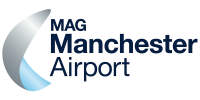Enhanced Terminal Airspace using RNP Based Operations at Manchester Ringway Airport
Timeline
Description
The main objective is to implement procedures for departure, arrival and initial approaches using PBN/RNP in high density TMAs, as detailed in the RNP 1 specification.
The implementation will facilitate increased safety and throughput for operators in associated High-Density Terminal Manoeuvring Area (TMA). For Manchester Ringway Airport the IP aims to develop and implement RNP1 SIDs (Standard Instrument Departure Routes) procedures and Arrival transition procedures for Runways (RWYs) 23R, 23L,05R and 05L.
This will involve converting the conventional SIDs and arrival routes to RNP1 design standards as per the ICAO and EASA standards to achieve PCP (Pilot Common Project) compliance. This will facilitate increased safety by incorporating GNSS technology and on-board monitoring and alerting for aircraft and will deliver a better integration for Manchester Ringway Airport to the En-Route network.
Within this IP a procedure design organisation will be appointed to work with identified stakeholders to optimise arrival and departure routes for Manchester Ringway Airport. The state regulator will be informed about the intention to design and implement RNP based operations in line with the requirements of the UK CAA (Civil Aviation Authority) CAP (Civil Aviation Publication) 1616 documentation.
A comprehensive design and public consultation process will be undertaken with clear and concise communication materials, as required by the regulatory process. Full environmental impact studies will be conducted as required which will analyse both the noise and fuel burn benefits.
UK airspace is being fundamentally re-designed to improve efficiency and safety, through NATS PLAS (Prestwick Lower Airspace Systemisation) project, and this project will integrate Manchester Ringway Airport into this wider en-route network with higher efficiency.
In addition, this project will close the identified gaps within family 1.2.3 for Manchester Ringway Airport.
This project is directly linked with CEF Call 2014 (Action 2014-EU-TM-0136-M) IP #119_AF1 (Implementing Partner NATS Nerl) in which the RNP1 SID was introduced by the design of the Point Merge and has an interdependency with 2017_024_AF1.
Specific objectives:
The Implementation Project aims to:
Design and implement RNP1 Arrival transitions for all runways.
Design and implement RNP1 SIDs for all runways.
Publish the RNP1 procedures in UK Aeronautical Information Publication (AIP)
Undertake a Public Consultation of new RNP SIDs
Develop a Safety assessment and an operational validation,
Validate the procedure by a flyability simulation,
Expected results
The following results are expected:
The main Gaps for family 1.2.3 for Manchester Ringway Airport are closed.
The integration for Manchester Ringway Airport to the on-route network is improved.
It will be possible to remove the outdated ground based VOR infrastructure in line with PCP objectives.
More flexible and environmentally friendly procedures for aircraft using RNP1 routes in the high density Manchester TMA
Spread of flight tracks during turns is reduced therefore reducing flown track miles.
The on-board capability of aircraft to perform monitoring and alerting can be effectively utilised which enhances safety.
Performance Benefits:
The new RNP1 procedures will deliver better integration for Manchester Ringway Airport to the en-route network and will also link directly to the RNP Approaches that are also being implemented. This creates a consistent operation within the Manchester TMA and will provide an environmental benefit by facilitating Continuous Descent Operations (CDO) which reduce airline fuel burn and costs.
These CDOs will also create a noise reduction benefit within the highly populated areas surrounding Manchester Ringway Airport due the elimination of level segments of flight that require thrust to be increased.
For departures, a more consistent operation within the TMA will be provided with environmental benefits resulting from aircraft flying Continuous Climb Operations (CCO) on departure which provide a similar benefit in reducing noise and fuel burn.
In addition, all of the RNP1 procedures will deliver increased aircraft safety through the provision of procedures that utilise the Area-NAV (RNAV) and on-board monitoring and alerting capability of the aircraft. These provide an indication to aircrew of any deviation from intended track and therefore provide an assurance on aircraft position."
Countries involved
Additional Information
- Project Type: Airport
- CEF Call Year: 2017
- Civil/Military: Civil
- Multistakeholder: No
- Main AF: AF1 - Extended Arrival Management and Performance Based Navigation in high density Terminal Manoeuvring Area
- Sub AF: S-AF 1.2 - Enhanced Terminal Airspace using RNP-Based Operations
- Progress Percentage: 37%
